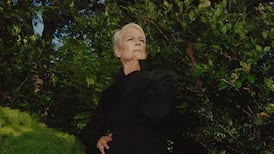The artists formerly known as RackaRacka require no drawing out. Danny and Michael Philippou, Australian YouTubers turned acclaimed horror directors, share answers like doubles partners in an Olympic ping-pong match. You’re never quite sure who’s replying. But you know the ball will be moving at speed.
We last met a little over two years ago. Talk to Me, the twins’ first-rate supernatural shocker, was receiving raves after a smash US debut at Sundance Film Festival. They were enjoying the surprise elevation. I imagine making Bring Her Back, the follow-up, may have been a bit more nerve-racking. They once had nothing to lose. The new film was easier to finance, but now there were expectations.
“Definitely way more pressure,” Michael practically yells. “There was a kind of prebuilt expectation, whereas the first time there wasn’t. So you’re exactly right. It was easier to get it up, but then it also had a lot more eyes on it. The first critics screening was the most terrifying thing ever.”
“There was an expectation of how it would be received by critics,” Danny adds. “I didn’t expect that. I still don’t know what the hell we’re doing. We always feel out of our depth. The pressure was on.”
READ MORE
I’ll trust him when he says they don’t think they know what they’re doing. But the Adelaide lads, now 32, still radiate a blistering confidence. At any rate, they needn’t have worried about Bring Her Back. The chilling new film, which expands and intensifies their transgressive aesthetic, stars Billy Barratt and Sora Wong as troubled orphans sent to live with an apparently amiable former social worker.
Pay heed to that “apparently”. It soon transpires their new foster mum – in the deceptively familiar form of Sally Hawkins – has been driven to necromancy by the death of her own daughter. Genuinely horrible events follow. At the early public screening I attended, grown adults were covering their eyes and hyperventilating. But, as well as delivering gross shocks, the film has important things to say about the process of grief.
“Our cousin lost her two-year-old while we were writing,” Danny says. “So I think that made its way into it. And then our family friend passed away right at the start of pre-production. That, again, shifted and changed the script. It altered where we were going and the tone of things. You’re always trying to be as personal as possible and to write from real experience.”
The time has, perhaps, passed for us to treat the Philippous’ route into cinema as novelty. Film-makers once saved every penny to buy stock for their Super 8 cameras. They went to film school. A later generation came up through advertising. The one after that honed its skills on pop videos. For the past decade or so, YouTube and its competitors have provided a hotter path to the big screen.
The lads began by filming their own backyard wrestling matches. By 2013 they had launched a YouTube channel called RackaRacka and were scoring hits with parodies such as (do we need to explain?) Harry Potter vs Star Wars.
“I hope that this helps other YouTube creators get their foot in the door,” Danny says. “While we were trying to get Talk to Me up, it was not easier because we were YouTubers. That was to our detriment a little bit. A lot of people would say, ‘What have they done?’ We’d send them YouTube videos for an example. They’re, like, ‘What the f**k? We’re not funding this.’ There was a little bit of that.
“But there’s a whole generation of people who are going to become film-makers that have access to Instagram or TikTok or YouTube – people that are storytellers at heart.”
Some Australian veterans were supportive. The creator of Mad Max is just the sort of fellow you’d expect to warm to these renegades.
“George Miller was the first film-maker that we spoke to who said, ‘If had YouTube back in the day, I would be on it. One hundred per cent’.” Danny confirms. “He was the first film-maker we’d known who was not looking down at us. He could embrace it. That was back in 2015. Even now the attitude is changing with the studios. Which is great. It’s so rare for an Australian film to break through and get seen.”
[ ‘It was our film and Oppenheimer. I thought, What the f**k? This is crazy’Opens in new window ]
Talk to Me really did land like a doodlebug. Following that triumphant Sundance premiere, distributors were fighting over the title in the foyer. It got raves. It took close to $92 million on a budget of less than $5 million. My guess if that, after the film proved a hit, they must have got offers from all directions. They are just the sort of guys who Marvel or DC like to inveigle into the franchise game. Can they tell me what they turned down?

“We can’t speak specifically what we were in talks about,” Michael says. “It felt like every door had blown open. We had so many amazing opportunities. We had offers. I guess there was an expectation to go bigger and broader. You have to step it up. But we wanted to do something that was personal to us and felt right in a story – not to be won over by a Hollywood offer. That’s not to say we wouldn’t do that in the future.”
They will point out that they were not complete novices when they moved to the big screen. They had worked on the crew of such features as Jennifer Kent’s groundbreaking The Babadook. But the assurance is still astonishing. Neither of their two films has a hint of ramshackle about it. Lushly shot by Aaron McLisky, Bring Her Back, again making great use of Australia’s humid suburbia, is as rich in its visuals as any studio blockbuster.
They are disciplined guys. When you ask film-making brothers how the work is divided, they usually hum and haw. That is not the case with the current directors. The Philippous, of Greek descent, are clear as to who does what.
“Yeah, especially with post-production,” Michael says. “Danny would be more focused with colour and VFX; myself with the sound and the music. That’s how we do those different things. But we’re both there every day in the edit. We’re both there for every day on set. The writing is more Danny with the co-writer [Bill Hinzman]. And I’ll give input there. I couldn’t imagine doing this completely by myself. My hat goes off to directors who do that. Seems an impossible task.”
They look to have a great connection with their actors. Barrett and Wong are utterly convincing in the juvenile roles. Sally Hawkins, the Oscar-nominated star of The Shape of Water and Happy-Go-Lucky, revels in the opportunity to move away from the warmer characters she so often plays. There is maybe a little of Paddington’s pal in the opening scenes, but, as events progress, the Londoner gets to roar, rant and spit blood.
“Sally is so great. She’s such a character actor,” Michael says. “Every film that she does, she embodies a completely different person. So the idea of a sinister version of that was so fascinating to us. We didn’t think she’d actually say yes. She’d never done a full, proper horror film before – a villain like this.”
The Philippous admit that they were looking back to scary mature ladies from earlier horror films. One thinks of Bette Davis in What Ever Happened to Baby Jane? (More “horror-adjacent”, perhaps.) Kathy Bates in Misery meets the criteria. Also, Beryl Reid and Flora Robson in the British cult gem The Beast in the Cellar.
“I love the psycho-biddy genre,” Danny says. “I love a really powerful actor like Bette Davis going to these extremes. She always would have to play things really realistically. She would be at seven, but the genre allowed her to hit 10. It’s such a big performance. That’s what’s so exciting about the genre, how it allows these actors to really play.”
As we speak, the brothers have made it back home for a spell. They are working on a documentary about deathmatch wrestling. One wonders if success has changed their relationship. It doesn’t seem that way.
“Exactly the same,” Danny says with a cackle. “We fight just as much. Yeah, I don’t think anything has changed between us at all.”
Bring Her Back is on general release


















